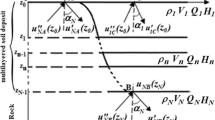Conclusions
-
1.
On the basis of the consistent physical hypothesis of the nature of stresses in the preparation of a seismic event, the author proposes a mathematical model of the radiator.
-
2.
The algorithms of displacements in longitudinal and transverse waves and the moduli of their amplitude spectra have been calculated.
-
3.
The equations D0=W0Δγ and νo.5 =f(LW 2o ) obtained have made it possible to propose a new method for estimating the focus characteristics with minimal number of free parameters.
Similar content being viewed by others
Literature Cited
B. V. Kostrov, Mechanics of a Tectonic Earthquake Focus [in Russian], Nauka, Moscow (1975).
A. G. Moskvina, “Possibility of determining certain characteristcs of an earthquake focus from the spectra of body waves”, Izv. Akad. Nauk SSSR, Fiz. Zemli, No. 11 (1971).
J. Brune, “Tectonic stress and the spectra of seismic shear waves from earthquakes”, J. Geophy. Res.,75 (1970).
T. C. Hanks and M. Wyss, “The use of body-wave spectra in the determination of seismicsource parameters”, Bull. Seismol. Soc. Am.,62 (1972).
J. C. Savage, “Relation of corner frequency to fault dimensions”, J. Geophy. Res.,77 (1972).
K. N. Khattri, “Determination of earthquake fault plane, fault area and rupture velocity from the spectra of long period P-waves and the amplitude of SH-waves”, Bull. Seismol. Soc. Am.,59 (1969).
E. I. Shemyakin and V. I. Shcheglov, “Mechanism of movements during crustal earthquakes”, Izv. Akad. Nauk SSSR, Fiz. Zemli, No. 12 (1974).
G. Latham et al., “Seismic data from man-made impacts on the Moon”, Science,170 (1970).
G. Latham, et al., “Moonquakes”, Science,174 (1972).
T. H. Heaton, “Tidal triggering of earthquakes”, Geophys. J. R. Astron. Soc.,43, No. 2 (1975).
N. Toksöz, N. Goins, and C. Cheng, “Moonquakes: mechanisms and relations to tidal stresses”, Science,196, No. 4293, May 27 (1966).
V. I. Shcheglov, “Some aspects of the problem of an earthquake focus”, Author’s Abstract of Candidate’s Dissertation, Novosibirsk (1978).
E. I. Shemyakin, “The stress-strain state at the apex of a break during antiplane deformation of rocks”, Fiz.-Tekh. Probl. Razrab. Polezn. Iskop., No. 1 (1973).
F. A. McClintock and A. S. Argon, Mechanical Behavior of Materials, Addison-Wesley (1966).
V. I. Keilis-Borok, “Sources approximately equivalent to earthquake foci”, Tr. Geofiz. Inst. Akad. Nauk SSSR, No. 9 (136) (1950).
N. A. Haskell, “Elastic displacement in the near-field of a propagation fault”, Bull. Seismol. Soc. Am.,59 (1969).
T. Mikumo, “Long-period P waveforms and the source mechanism of an intermediate earthquake”, J. Phys. Earth,17, No. 2 (1969).
M. Ohnaka, “A physical understanding of the earthquake source mechanism”, J. Phys. Earth,21, No. 1 (1973).
Y. Okada, “The difference in the duration of P and S waves from propagating faults”, J. Phys. Earth,18, No. 2 (1970).
Additional information
IGiG, Siberian Branch, Academy of Sciences of the USSR, Novosibirsk. Translated from Fiziko-Tekhnicheskie Problemy Razrabotki Poleznykh Iskopaemykh, No. 5, pp. 18–28, September–October, 1978.
Rights and permissions
About this article
Cite this article
Shcheglov, V.I. Determination of the parameters of a shear source of seismic radiation. Part I. Soviet Mining Science 14, 450–457 (1978). https://doi.org/10.1007/BF02499696
Received:
Issue Date:
DOI: https://doi.org/10.1007/BF02499696




